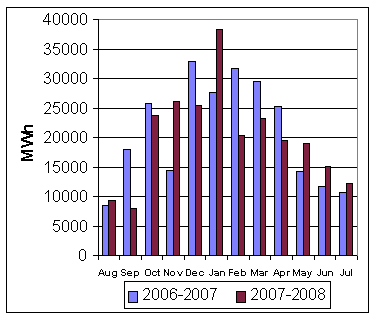
Monthly energy output at Erie Shores Wind Farm in Ontario, Canada. It peaks in winter and reaches a minimum in the summer.
There are several challenges that arise when integrating wind energy into the electricity grid.
Wind speeds can vary from hour to hour, from day to day and from season to season. In addition, the times when the wind is strong do not necessarily correspond to peak demand. At the moment this means that wind can only be relied on for a part of energy demand, while the rest is made up with energy sources that can be turned on and off as required.[1]
There are two main strategies for dealing with the variability of wind: either distribute wind turbines across a large enough area so that any variations mostly cancel out, or try to store the energy so that it can be fed back into the grid when the wind is low. The first strategy broadly works, but weather patterns can sometimes correlate on continent-wide scales; as for storage, some technologies are promising, but none so far are both economical and scalable.[2]
Another problem with wind is that the windiest sites can be remote from the cities where electricity is needed. Standard high voltage alternating current (HVAC) transmission lines tend to lose a lot of power to resistance in the wires over long distances, so many countries are now considering a high voltage direct current (HVDC) grid. HVDC has much lower losses, but parts of the technology still need to mature.
Finally onshore wind farms have been criticised for being noisy and unsightly.
Despite these challenges, wind power remains one of the cheapest and most viable sources of renewable energy. It has a low environmental impact, costs very little to run once set up and is already widely deployed and tested in the real world.
The maximum fraction of energy supply for wind is put around 20% for a small country, without further losses (curtailment). [Giebel 2000]
Storage systems include pumped water hydropower, compressed air storage, flywheels, batteries and hydrogen storage. See Wikipedia: Grid energy storage for more details.
There are some reports of birds and bats being killed by wind turbines, but this problem does not seem to be widespread.
[Giebel 2000] G. Giebel, " On the Benefits of Distributed Generation of Wind Energy in Europe," Dissertation, Universität Oldenburg, 2000, available here.
Author: Tom Brown
Copyright: public domain
Date last modified: 11th Oct 2011
Peer-review status: Not yet peer-reviewed
http://commons.wikimedia.org/wiki/File:Erie_Shores_Wind_Farm_output_Aug-Jul_2008.gif: By Delphi234 (Own work) [Public domain], via Wikimedia Commons